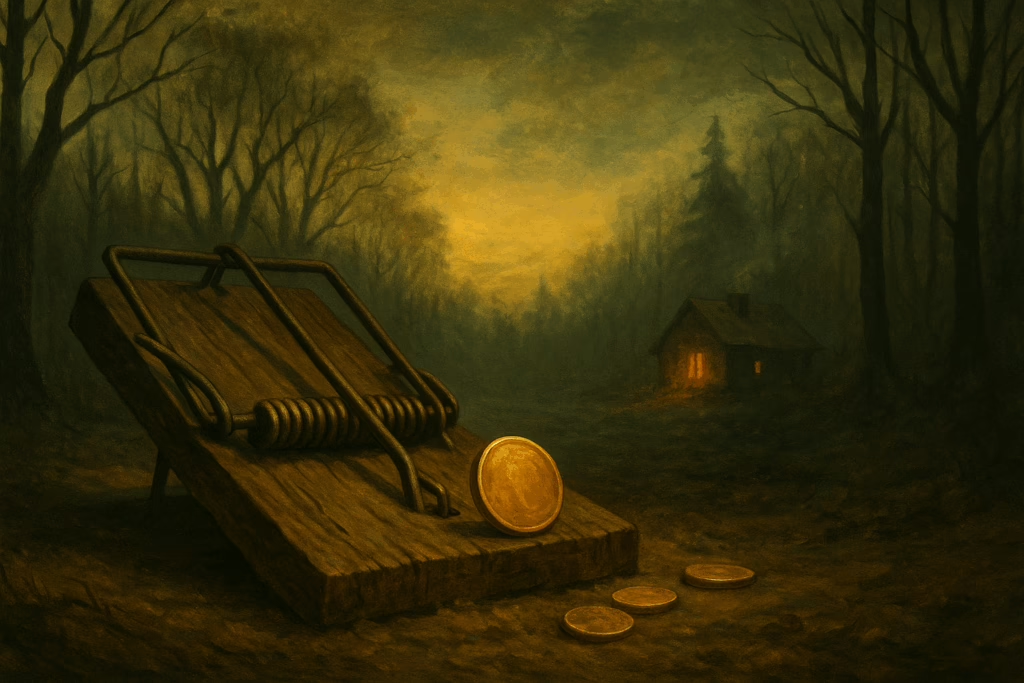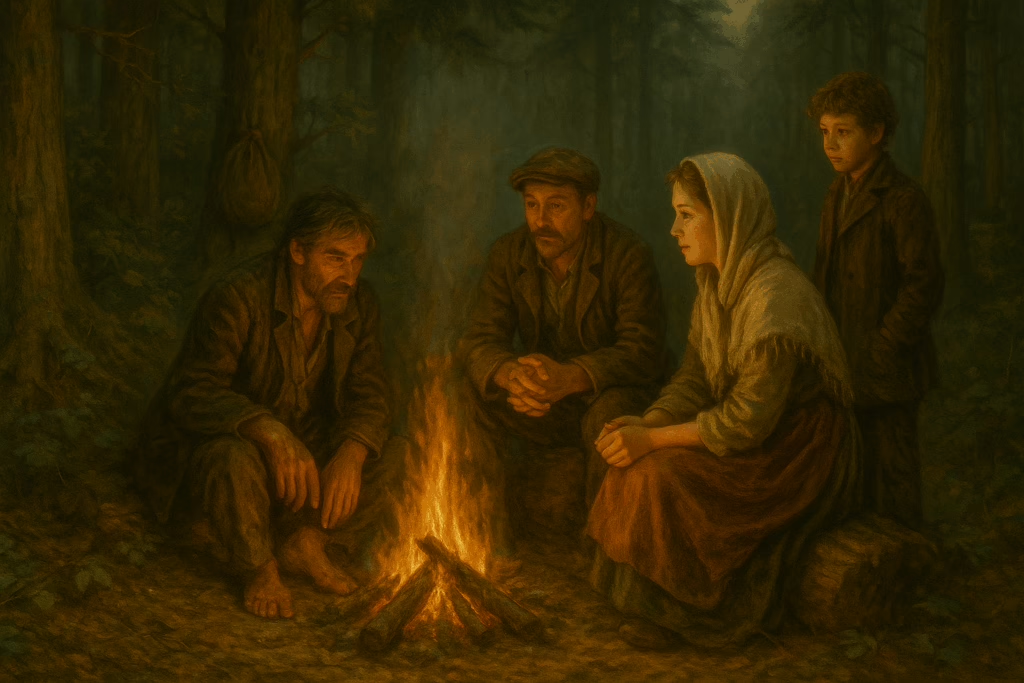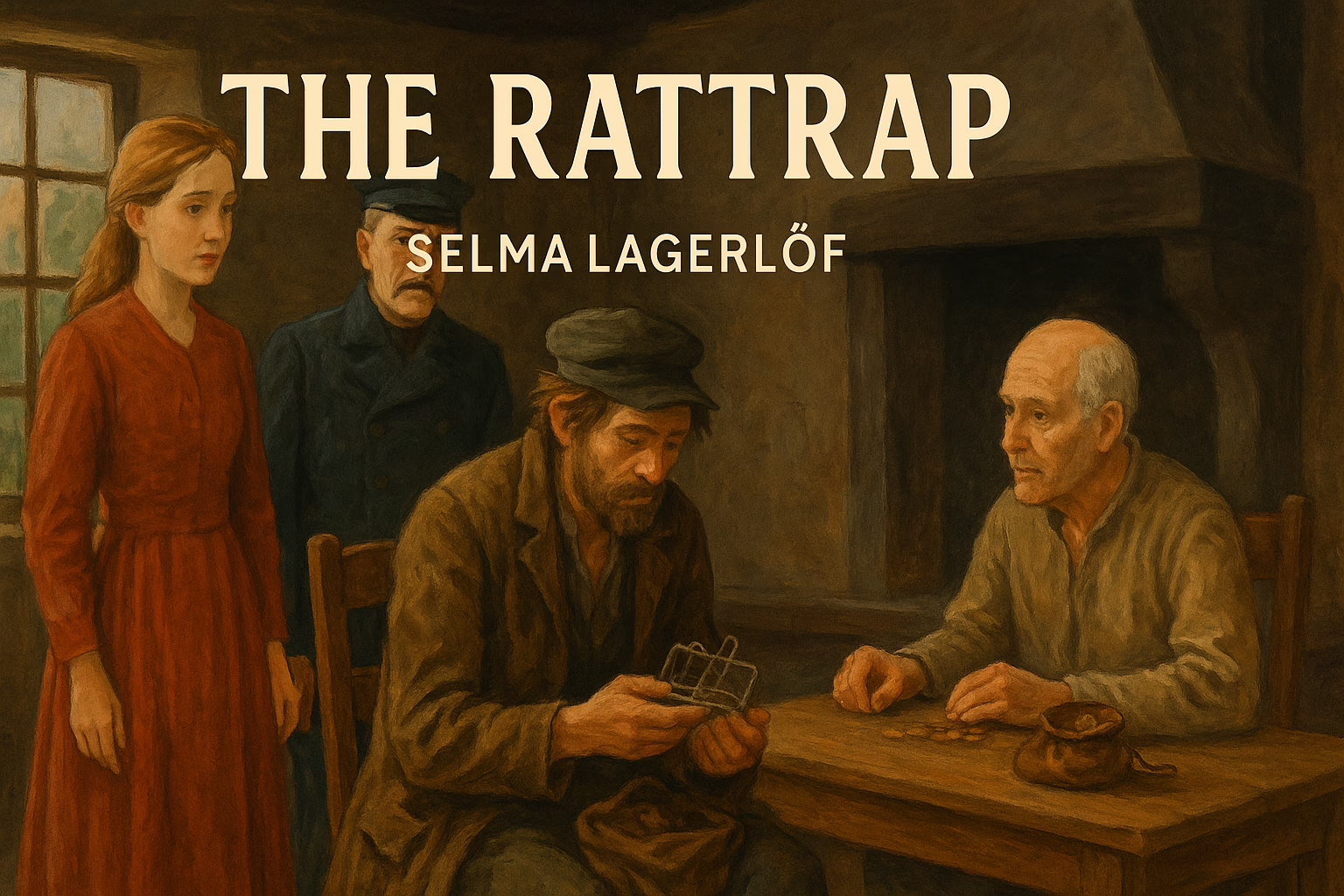Summary of The Rattrap
The Rattrap is a story about human loneliness, the power of kindness, and the possibility of redemption. The protagonist is a poor, homeless rattrap seller who leads a life of misery and mistrust. One day, while reflecting on his own condition, he imagines that the entire world is a giant rattrap full of temptations—riches and comforts—that trap people when they give in to greed.
He receives unexpected kindness from a lonely crofter, who welcomes him into his cottage, offers him food, shares stories, and even shows him his thirty kronor. However, the peddler betrays this trust by stealing the money. While escaping through the forest, he loses his way and realises, with bitter humour, that he has himself fallen into the “rattrap” of temptation.
Trying to escape, he wanders into the ironworks, where the ironmaster mistakes him for an old regimental friend, Captain Nils Olof. The peddler refuses the offer to go home with him, fearing discovery, but the ironmaster’s daughter, Edla Willmansson, persuades him with genuine compassion. Unlike the ironmaster, who changes his attitude when he learns the truth, Edla treats the peddler with dignity even after discovering he is not a captain.
Her kindness transforms him. Before leaving on Christmas morning, the peddler gifts Edla a small rattrap containing the stolen thirty kronor and a letter. In the letter, he writes that because she treated him like a gentleman, he wanted to become one. He signs the letter as “Captain von Stahle,” showing that he has risen morally to the title she gave him.
The story beautifully conveys that compassion and understanding can awaken the goodness hidden in every human heart.
About the Author — Selma Lagerlöf
Selma Lagerlöf (1858–1940) was a celebrated Swedish novelist and one of the most influential writers of her time. She became the first woman to win the Nobel Prize in Literature in 1909, recognised for her imaginative storytelling, deep moral insight, and vivid narrative style. Born in Mårbacka, Sweden, Lagerlöf grew up listening to folklore and legends, which later shaped the symbolic and philosophical qualities of her writings.
Her works often explore themes of compassion, human dignity, redemption, and the power of goodness—qualities strongly reflected in The Rattrap. Known for blending realism with gentle moral lessons, Lagerlöf wrote several acclaimed novels, including Gösta Berling’s Saga and The Wonderful Adventures of Nils. Her writing stands out for its warmth, empathy, and belief in the possibility of change in every human being.

Textual Questions and Answers
COMPREHENSION CHECK (Page 34–41)
1. From where did the peddler get the idea of the world being a rattrap?
The peddler got the idea when he was thinking about his own rattraps. He suddenly imagined that the entire world, with its offers of riches and comforts, functioned like a giant rattrap designed to tempt human beings with bait and then trap them.
2. Why was he amused by this idea?
He was amused because he had always received harsh treatment from the world, and thinking ill of it gave him a sense of satisfaction. The idea that others might also get caught in the world’s snare brought him unwonted joy.
3. Did the peddler expect the kind of hospitality he received from the crofter?
No, the peddler did not expect such kindness because he was used to being turned away with sour faces. The crofter’s hospitality came as a pleasant surprise to him.
4. Why was the crofter so talkative and friendly with the peddler?
The crofter was lonely, with no wife or children. He felt happy to have company, so he welcomed the peddler warmly, offered him food, shared tobacco, and talked freely about his life.
5. Why did he show the thirty kronor to the peddler?
He showed the thirty kronor because he wanted to prove that his cow truly was extraordinary and that she gave him enough milk to earn a good income. He felt proud and wanted his guest to believe him.
6. Did the peddler respect the crofter’s confidence in him?
No, the peddler did not respect the crofter’s trust. After leaving, he returned, broke the windowpane, stole the thirty kronor, and ran away.
7. What made the peddler think that he had indeed fallen into a rattrap?
When he entered the forest to avoid being caught, he realised he was walking in circles. As darkness fell, the forest closed around him like a prison. Then he remembered his own metaphor and felt he had been trapped by the bait of the stolen money.
8. Why did the ironmaster speak kindly to the peddler and invite him home?
The ironmaster mistook him for his old regimental comrade, Captain Nils Olof. Believing he was meeting an old friend, he spoke warmly and invited him home for Christmas.
9. Why did the peddler decline the invitation?
The peddler declined because he feared that if he went to the manor, the stolen thirty kronor might be discovered. He did not want to walk into danger voluntarily.
10. What made the peddler accept Edla Willmansson’s invitation?
Edla spoke kindly, respectfully, and with genuine concern for his comfort. Her compassion and gentle assurances made the peddler trust her and accept the invitation.
11. What doubts did Edla have about the peddler?
Edla suspected that he might have stolen something or escaped from jail because he seemed frightened and behaved oddly when she met him.
12. When did the ironmaster realise his mistake?
The ironmaster realised his mistake the next morning when the peddler entered the room in clean clothes. In broad daylight, it was impossible to mistake him for Captain Nils Olof.
13. What did the peddler say in his defence?
The peddler said he never claimed to be the captain. He had begged to stay in the forge, and he was ready to leave and put his rags back on. He argued that the world itself was a rattrap, and he had merely fallen into temptation.
14. Why did Edla still entertain the peddler after hearing the truth?
Edla felt that he had nowhere to go where he was welcome. She wanted him to have one day in the year when he could eat, rest, and feel safe. Her compassion made her insist on letting him stay for Christmas.

UNDERSTANDING THE TEXT
1. How does the peddler interpret the kindness of the crofter, ironmaster, and Edla?
The peddler sees the crofter’s kindness as easy bait, which he eventually steals. He misinterprets the ironmaster’s kindness as a trap and fears punishment. Only Edla’s kindness touches him deeply because she treats him with dignity, respect, and genuine human concern. He feels her compassion is sincere and not bait, which ultimately changes him.
2. How does the ironmaster differ from his daughter?
The ironmaster is impulsive, proud, and quick to judge. He insists on bringing home the stranger only because he believes him to be an old comrade. When he discovers the truth, he becomes harsh and threatens to call the sheriff.
In contrast, Edla is gentle, compassionate, and understanding. She respects the stranger as a human being, gives him freedom, and treats him with kindness even after discovering his identity.
3. Identify unexpected reactions from characters.
- The crofter unexpectedly welcomes the peddler warmly.
- The ironmaster mistakes the vagabond for an old friend.
- The peddler unexpectedly refuses the ironmaster’s offer.
- Edla invites him home despite suspecting him.
- The peddler unexpectedly leaves behind the stolen money and a gift.
4. What made the peddler finally change his ways?
It was Edla’s kindness, trust, and respect. She treated him like a captain and made him feel he was worthy of honour. Her compassion awakened the goodness within him and inspired him to return the stolen money.
5. How does the metaphor of the rattrap highlight the human predicament?
The metaphor suggests that the world lures people with material temptations—riches, food, warmth, and shelter—just like a rattrap uses bait. Once people fall for greed or temptation, they get trapped in guilt, punishment, or misery. The peddler’s own life, and even the ironmaster’s mistake, illustrate this human weakness.
6. How does the peddler’s humour lighten the seriousness of the story?
The peddler uses witty remarks, especially when he says the whole world is a rattrap and warns the ironmaster that he too may one day get caught. His humorous way of viewing life reduces tension, makes him likeable, and softens the story’s deeper moral message.
TALKING ABOUT THE TEXT
(Model answers for class discussion)
1. Why was Edla happy to see the peddler’s gift?
Edla was happy because the peddler had not stolen anything and instead returned the crofter’s money. The gift proved that her kindness had awakened the man’s honesty and that her trust had not been misplaced.
2. Why did the peddler sign as Captain von Stahle?
He signed as “Captain von Stahle” because Edla had treated him like a real captain, and he wanted to return her respect. He also wanted to show that her kindness had elevated him morally.
3. Why is the reader’s sympathy with the peddler from the beginning?
The reader feels sympathy for him because he is poor, lonely, hungry, and mistreated by society. His struggles make him a victim of circumstances. His wrongdoing is understandable and ultimately corrected.
4. How does the story show human loneliness and the need to connect?
The crofter welcomes a stranger because he is lonely. The peddler longs for warmth and acceptance. Edla wants someone to share Christmas with. Their actions reflect the universal need for companionship.
5. Give an example of a good deed changing someone’s worldview.
Students may answer personally, but a model answer:
A neighbour once helped a struggling man find a job instead of reporting him for petty theft. This act transformed the man’s outlook and made him honest and hardworking.
6. How is the story both entertaining and philosophical?
It is entertaining through its twists, mistaken identity, humour, and dramatic moments. Philosophically, it explores temptation, human weakness, redemption, and compassion.

WORKING WITH WORDS
1. List all terms used for the peddler and their implications.
- Peddler – indicates his occupation.
- Stranger – shows he was unknown to people.
- Tramp – suggests he is homeless and shabby.
- Vagabond – shows society’s dismissive attitude.
- Ragamuffin – refers to his ragged appearance.
- Captain – used humorously and respectfully after mistaken identity.
- Rat (in his letter) – shows his self-mocking humour and humility.
2. Five more words that show weary movement:
- Limp
- Shuffle
- Creep
- Hobble
- Drag
(All indicate tired, slow movement.)
NOTICING FORM
Examples of reflexive pronouns:
- “He had pulled himself together.”
- “He warmed himself by the fire.”
- “He asked himself why he had stolen the money.”
- “She blamed herself for mistrusting him.”
These are used for emphasis or to refer back to the subject.
THINKING ABOUT LANGUAGE
1. Phrases specific to ironworks:
- Pig iron
- Rolling mill
- Furnace
- Charcoal crates
- Bellows
- Forge
- Fire boy
- Smelter
These belong to the vocabulary of metallurgy.
2. Indoor games in your region (examples):
- Ludo
- Carrom
- Chess
- Snakes and Ladders
- UNO
- ‘Chopar’ / ‘Dayakattam’
- Cards
3. Other terms for a small farmer:
- Peasant
- Sharecropper
- Tillerman
- Cultivator
- Tenant farmer
(In Bengali: chashbash, bhagchashi.)


